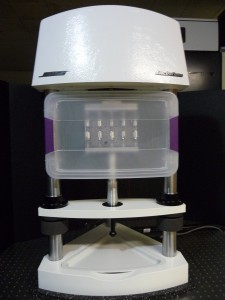 An important input to FEA is material characterization and limit information. In our laboratory we use a Bose 3230 test system for achieving test speeds up to 200Hz. Depending on the project, we may test complete devices, sub-components, coupon samples and/or simple material characterization samples. Many times, we will test more than one configuration to make sure our data are consistent and ultimately demonstrates the validation of an implantable medical device’s safety and efficacy.
An important input to FEA is material characterization and limit information. In our laboratory we use a Bose 3230 test system for achieving test speeds up to 200Hz. Depending on the project, we may test complete devices, sub-components, coupon samples and/or simple material characterization samples. Many times, we will test more than one configuration to make sure our data are consistent and ultimately demonstrates the validation of an implantable medical device’s safety and efficacy.
Many factors are involved in deciding what testing would be most efficient to support a product’s validation effort. Characterization of material properties is typically the first step. For medical implants that utilize advanced materials, fine geometric features and deliberate metallurgical processing, it is important to capture these in the specimen design. Fabrication of appropriate samples takes the most effort compared to the relatively short test times and the simplicity of material characterization tests.
After material characterization, testing to validate the performance features of an implant are typically necessary. These tests may also require the fabrication of appropriate samples but can additionally involve the reproduction of complex in vivo load states. Besides verifying that the test setup reproduces the desired load state, performance testing is short term and individual samples can be tested in series to study the effect of loading magnitudes, variations in processing, load combinations, etc. Many times, these studies to quantify the impact of such variables play an important role in a validation strategy and can be efficiently performed since only one or a few cycles of loading are required.
Beyond material characterization and performance testing, material limit properties are the next category of data necessary for input to FEA models. When the required number of cycles is low, say 10 million or fewer, accelerated testing can be performed on individual samples tested in series or multiple samples tested simultaneously. The advantage of testing individual samples was mentioned above while testing multiple samples simultaneously produces stronger statistics more quickly.
When the required number of cycles reaches 100 million or more, a balance between testing enough samples for the desired confidence level and testing the samples to run out at the high cycle limit must be reached. A typical strategy might involve a combination of testing individual samples to 10 million cycles and then selecting one or more loading conditions/levels for testing multiple samples simultaneously. Such a scenario takes advantage of the relatively short testing time frame for a 10 million cycle test (on the order of 1-2 days, compared to 4-6 weeks for testing to 400 million cycles) and the statistical advantage of testing multiple samples.
In the photo above, a multiple sample fixture capable of testing 12 fatigue coupon samples in a controlled temperature chamber is shown. Such a fixture must be fabricated and aligned very carefully to insure identical loading conditions are achieved for all of the samples. Stroboscopic verification, randomized experimental design, fracture surface investigation and other experimental mechanics techniques also help to build confidence in a validation test methodology.
